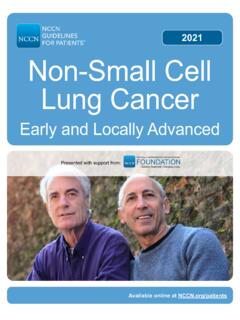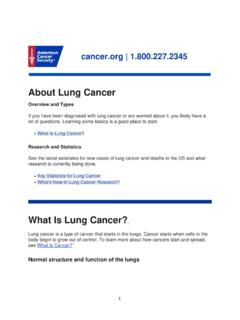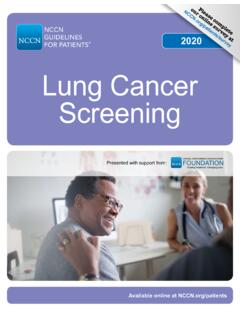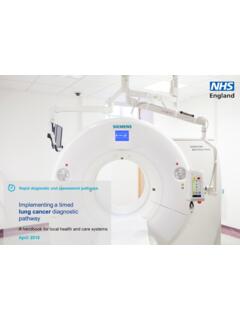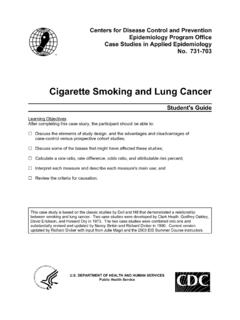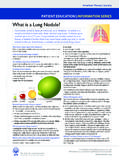Transcription of Lung Cancer Screening Programs
1 1 POLICIES & PRACTICES FOR Cancer PREVENTIONLUNG Cancer Screening PROGRAMSN ational Center for Chronic Disease Prevention and Health Promotion Division of Cancer Prevention and Control2 POLICIES & PRACTICES FOR Cancer PREVENTIONCDC funds states, tribes, Affiliated Pacific Islands, and territories through the National Comprehensive Cancer Control Program (NCCCP) to form or support coalitions to fight Cancer in their communities. The purpose of this report is to describe how NCCCP grantees can increase awareness about lung Cancer Screening Programs , including cigarette smoking cessation, for persons at high risk for lung Cancer .
2 Examples of lung Cancer Screening -related activities conducted by some NCCCP grantees are also provided. Lung Cancer is the leading cause of Cancer deaths among adults in the United States. In 2012, there were 210,828 cases of and 157,423 deaths from lung Some groups have higher rates of new cases and death rates of lung Cancer than others. The risk of lung Cancer increases with age; therefore, older persons have higher rates than younger persons. Current cigarette smokers have higher rates of new lung Cancer cases than persons who never smoked or who quit Ten years after a person quits cigarette smoking, his or her risk for lung Cancer drops by If lung Cancer is diagnosed before it has spread to other parts of the body, the 5-year survival rate is 55%.
3 4 Lung Cancer is frequently diagnosed after it has spread, with survival rates ranging from to While lung Cancer death rates have decreased over the past decade, many people continue to die from the goal of lung Cancer Screening is to enable detection of lung Cancer before it has spread. Treatment can then be provided, which may reduce the likelihood of dying from lung Cancer . However, lung Cancer Screening does not prevent the development of lung Cancer . The best ways to reduce the risk of lung Cancer are to not start smoking cigarettes, to quit if you smoke, and to avoid secondhand Thus, lung Cancer Screening Programs need to promote cessation of cigarette smoking among current smokers, and continued abstinence among former & PRACTICES FOR Cancer PREVENTIONCIGARETTE SMOKING CESSATIONWhat Resources are Available to NCCCP Grantees and Partners?
4 CDC has many resources to help people quit smoking (see ), including fact sheets, information about quitlines, free multimedia items that can be downloaded, and links to resources for state and community tobacco control Programs . Tips from former smokers living with smoking-related diseases and conditions (Tips from Former Smokers campaign) are also available and may be accessed at Resources for locating evidence-based strategies for reducing cigarette smoking and secondhand smoke exposure are found in Box 1. RESOURCES FOR EVIDENCE-BASED COMMUNITY-BASED STRATEGIES FOR CIGARETTE SMOKING CESSATION Cessation Materials for State Tobacco Control Programs ( ) Best Practices for Comprehensive Tobacco Control Programs , 2014 ( ) The Community Guide to Reducing Tobacco Use and Secondhand Smoke Exposure ( )What Effective Cessation Treatments are Available?
5 Concerns about smoking-related health conditions, including lung Cancer , could provide a powerful motivation for smokers to quit smoking. Because smoking is highly addictive, most smokers try to quit several times before succeeding, which means that health care providers often need to provide repeated help in this process. Smokers can improve their chances of quitting by using effective cessation treatments. These treatments include individual, group, and telephone counseling and seven FDA-approved cessation medications (including over-the-counter and prescription medications and nicotine and non-nicotine medications).
6 As a result of the Affordable Care Act, coverage of cessation treatments is improving, but is still not comprehensive for all private insurance, Medicaid, and Medicare The CDC ( ) and the American Lung Association ( ) have summarized guidance from the Department of Health and Human Services on insurance coverage of tobacco cessation as a preventive service, including the types of health plans that are required to provide this coverage. 34 POLICIES & PRACTICES FOR Cancer PREVENTIONPOLICIES & PRACTICES FOR Cancer PREVENTIONWhat Could Health Care Providers Do?
7 Physicians and other health care providers play a critical role in motivating and helping smokers to quit. The 2008 Public Health Service Clinical Practice Guideline on Treating Tobacco Use and Dependence outlines a 5 A s approach that clinicians should follow with patients who smoke, including (1) asking about tobacco use at every visit, (2) advising patients to quit, (3) assessing patients willingness to make a quit attempt, (4) assisting patients in quit attempts, and (5) arranging Even brief advice to smokers improves quit rates, with more intensive advice and assistance having a progressively greater impact.
8 In addition to providing direct counseling and assistance, health care providers and their teams could prescribe cessation medications for eligible smokers and refer them to other resources for more intensive help. One such resource is telephone quitlines, which have been shown to increase quit rates, to have broad reach, and to be effective with diverse Quitlines provide callers with counseling, practical assistance, and, in many cases, free nicotine replacement Quitlines exist in all 50 states, the District of Columbia, Guam, and Puerto Rico; smokers can access their state quitline by calling 1-800-QUIT-NOW.
9 In addition to telephone services, most quitlines offer web-based cessation , 12 Quitlines referrals should be seen as a complement to, rather than a substitute for, direct cessation intervention performed by Could NCCCP Grantees Do? NCCCP grantees could continue to collaborate with their tobacco control partners to implement evidence based interventions for reducing cigarette smoking and secondhand smoke exposure identified in the Community Guide and in CDC s Best Practices for Tobacco Control Programs . Grantees could also work with comprehensive Cancer control coalitions to increase awareness among health care providers about the importance of collecting information on current cigarette smoking status and smoking pack years in their medical record systems.
10 This information could then be used to help health care providers identify and monitor persons who are at high risk for lung Cancer , as well as to consistently advise patients to quit smoking and to offer them assistance in doing so. Clinical practice guidelines for treating tobacco use and dependence, including among older smokers, are available for health care providers ( ). NCCCP grantees could explore partnerships with health care providers to develop stronger and more effective cigarette smoking cessation Programs in the context of lung Cancer Screening .










